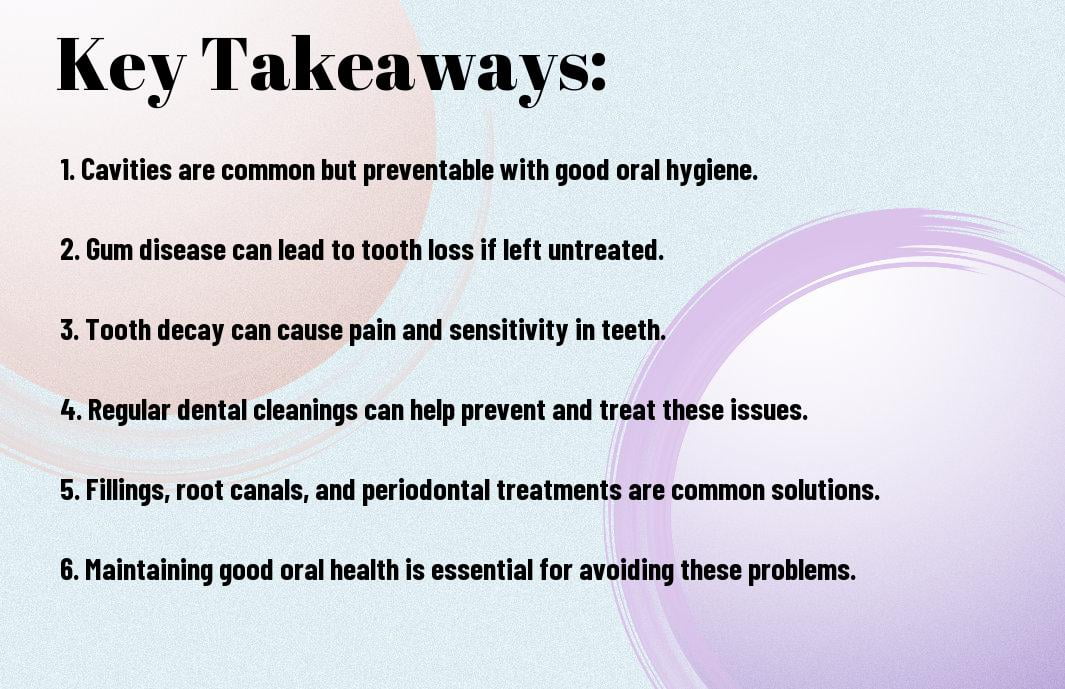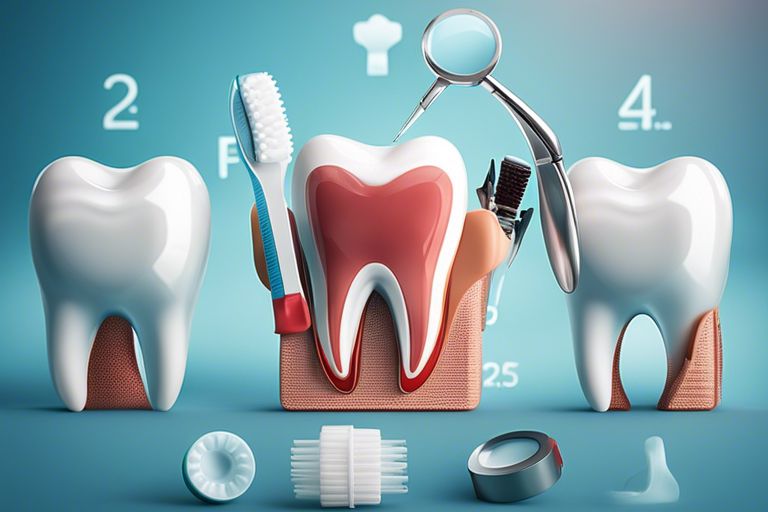It’s crucial to be aware of common dental problems that can affect you, and to understand the treatments available. Cavities, gum disease, and tooth decay are all common issues that many individuals face, and they can lead to serious consequences if left untreated. When it comes to cavities and tooth decay, the Mayo Clinic provides an informative guide on Cavities and tooth decay – Symptoms and causes, offering valuable insights into the causes and symptoms of these dental issues. By understanding the signs of these problems, you can take the necessary steps to prevent them and seek effective treatments if needed.
Key Takeaways:
- Cavities: One of the most common dental problems, cavities occur when bacteria in the mouth produce acids that erode the tooth enamel. Regular brushing, flossing, and dental check-ups can help prevent cavities, and treatments may include fillings or crowns to restore the affected teeth.
- Gum Disease: Also known as periodontal disease, gum disease is caused by the build-up of plaque and tartar, leading to inflammation and infection of the gums. Good oral hygiene and professional dental cleanings are crucial in preventing and treating gum disease, and more advanced cases may require scaling and root planing or surgical intervention.
- Tooth Decay: Tooth decay is the result of bacteria breaking down the tooth’s structure, leading to cavities and potential tooth loss. Regular brushing and flossing, along with a balanced diet and fluoride treatments, can help prevent tooth decay. In more advanced cases, treatments such as dental fillings, root canals, or dental crowns may be necessary to restore the affected teeth.

Cavities: Causes and Prevention
While cavities are one of the most common dental problems, they can easily be prevented with proper oral care and regular dental check-ups. Understanding the causes of cavities and how to prevent them is crucial for maintaining good oral health.
Understanding Tooth Decay
When you consume sugary or starchy foods and beverages, the bacteria in your mouth feeds on these substances and produces acid. Over time, this acid wears down the enamel of your teeth, leading to the formation of cavities. If left untreated, cavities can cause pain, infection, and even tooth loss.
Strategies for Cavity Prevention
To prevent cavities, it’s essential to brush your teeth at least twice a day with fluoride toothpaste, floss daily to remove food particles and plaque between your teeth, and limit sugary and acidic foods and drinks. Additionally, regular visits to your dentist for professional cleanings and check-ups are crucial for early detection and treatment of cavities.
Gum Disease: Risks and Management
Keep your gums healthy and free from disease as they play a crucial role in your overall oral health. Gum disease, also known as periodontal disease, is a common condition that can lead to serious complications if left untreated. It is caused by the buildup of plaque and tartar on the teeth, leading to inflammation and infection of the gums. If you notice symptoms such as red, swollen, or bleeding gums, it is important to seek treatment from your dentist to prevent the progression of gum disease.
Stages of Gum Disease
Gum disease progresses through three main stages: gingivitis, periodontitis, and advanced periodontitis. In the early stage, gingivitis, you may experience mild symptoms such as red and swollen gums, as well as bleeding when brushing or flossing. If left untreated, the condition can advance to periodontitis, where the infection spreads to the supporting bone and tissues. If the disease progresses to advanced periodontitis, you may experience severe damage to the bone structure supporting the teeth, leading to tooth loss.
Non-Surgical and Surgical Treatments
Non-surgical treatments for gum disease include professional dental cleanings to remove plaque and tartar, as well as root planing and scaling to smooth the root surfaces and remove bacteria. Your dentist may also recommend antibiotics to control the infection. In more advanced cases, surgical treatments such as flap surgery or bone and tissue grafts may be necessary to repair the damage caused by gum disease and restore the health of your gums and supporting structures. It is important to follow your dentist’s recommendations for treatment to effectively manage gum disease and prevent further complications.
Advanced Tooth Decay: Intervention and Restoration
Unlike minor cavities, advanced tooth decay requires extensive intervention and restoration to salvage the affected tooth. If left untreated, severe decay can lead to tooth loss, infection, and even spread to other teeth. It’s crucial to seek professional dental care if you suspect you have advanced tooth decay.
- Identifying Severe Decay
- Restoration Options
When you have severe tooth decay, you may experience intense and persistent toothache, sensitivity to hot or cold substances, visible holes or pits in your teeth, and bad breath. An X-ray may reveal the extent of the damage and help your dentist determine the best course of action.
If you have advanced tooth decay, your dentist may recommend a root canal procedure to remove the infected pulp and reinforce the tooth with a crown. In some cases, extraction may be necessary if the damage is extensive and irreparable, but this is typically a last resort. Your dentist will work with you to determine the best restoration option for your specific case.
Emerging Dental Treatments
Now let’s turn our attention to some of the latest advancements in dental treatments that are changing the way we address common dental problems. These emerging treatments offer new options for addressing issues such as cavities, gum disease, and tooth decay, providing improved outcomes and a better overall experience for you, the patient.
Innovative Materials for Fillings
One of the most exciting developments in dental treatments is the use of innovative materials for fillings. Traditional amalgam fillings have been the standard for many years, but new materials such as composite resins and porcelain offer several benefits. Not only do these materials provide a more natural appearance, but they also require less removal of healthy tooth structure and provide a stronger bond to the tooth. This means that you can have a more durable and attractive restoration that better preserves your natural tooth. Additionally, these alternatives are free from mercury, a toxic substance found in traditional amalgam fillings, which can pose health risks over time.
Advances in Gum Disease Therapy
Another area that has seen significant advancements is gum disease therapy. Thanks to improved understanding of the disease and technological innovations, treatments for gum disease have become more effective and less invasive. For example, laser therapy can target and remove infected tissue while promoting the regeneration of healthy gum tissue. This treatment not only reduces discomfort but also allows for a more precise and efficient removal of diseased tissue. By addressing gum disease with these advanced techniques, you can prevent further damage to your gums and overall oral health.
Common Dental Problems And Treatments, Such As Cavities, Gum Disease, And Tooth Decay
Now that you are aware of common dental problems such as cavities, gum disease, and tooth decay, it is important to remember that prevention is key to maintaining good oral health. By brushing and flossing daily, visiting your dentist regularly, and maintaining a healthy diet, you can significantly reduce your risk of developing these issues. If you do experience any of these dental problems, rest assured that there are effective treatments available, such as fillings and root canals for cavities, deep cleanings and antibiotic therapy for gum disease, and crowns or veneers for tooth decay. By staying informed and taking proactive steps to care for your teeth, you can maintain a healthy, beautiful smile for years to come.
FAQ – Common Dental Problems And Treatments
Q: What are cavities and how are they treated?
A: Cavities are caused by bacteria that produce acid, which erodes the tooth enamel. Treatment typically involves removing the decayed portion of the tooth and filling it with a dental filling material such as composite resin or amalgam.
Q: What is gum disease and how is it treated?
A: Gum disease, also known as periodontal disease, is an infection of the tissues that surround and support the teeth. Treatment involves professional cleaning to remove plaque and tartar buildup, as well as possible use of antibiotics or surgical intervention in more severe cases.
Q: How does tooth decay occur and what are the treatment options?
A: Tooth decay, or dental caries, is caused by the demineralization of the tooth enamel due to acids produced by bacteria. Treatment involves removing the decayed portion of the tooth and restoring it with a filling, crown, or in severe cases, a root canal procedure.
Q: What causes sensitive teeth and how can it be treated?
A: Tooth sensitivity can be caused by various factors such as exposed tooth roots, worn enamel, or dental cavities. Treatment can involve the use of desensitizing toothpaste, fluoride applications, or in more severe cases, bonding or a root canal procedure.
Q: How can I prevent common dental problems?
A: Prevention of common dental problems involves practicing good oral hygiene, including brushing and flossing regularly, avoiding sugary and acidic foods and drinks, and visiting your dentist for regular check-ups and cleanings. Maintaining a healthy diet and avoiding tobacco products can also help prevent dental issues.






